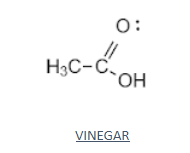
Draw structural formula for each of the following compounds:
Vinegar
Answer
550.5k+ views
Hint Structural formula identifies the location of chemical bonds between the atoms of a molecule. They are particularly useful for showing how compounds with the identical kind and number of atoms differ.
Complete answer:
- The structural formula or the molecular formula of an organic compound shows every bond between every atom within the molecule.
- A structural formula consists of symbols for the atoms connected by short lines that represent chemical bonds—one, two, or three lines standing for single, double, or triple bonds, respectively.
- The structural formula of vinegar is shown below

- Organic compounds, from any of the large classes of chemical compounds having one or more atoms of carbon are covalently linked to atoms of other elements, usually hydrogen, oxygen, or nitrogen.
-The few carbon-containing compounds not classified as organic include carbides, carbonates, and cyanides.
- Therefore, Vinegar is described as an organic compound, with the functional group carboxylic acid.
Additional information:
The main source of the carbon in organic compounds is carbon dioxide in the atmosphere. Plants use sunlight to convert carbon dioxide and water, which is an inorganic-compound, into sugar (an organic compound) through the process of photosynthesis.
Note: Carbon has four valence electrons, which means that each carbon atom can form a maximum of four bonds with other atoms. And due to the number of bonds that carbon can form with other atoms, organic compounds are often very complex.
Complete answer:
- The structural formula or the molecular formula of an organic compound shows every bond between every atom within the molecule.
- A structural formula consists of symbols for the atoms connected by short lines that represent chemical bonds—one, two, or three lines standing for single, double, or triple bonds, respectively.
- The structural formula of vinegar is shown below

- Organic compounds, from any of the large classes of chemical compounds having one or more atoms of carbon are covalently linked to atoms of other elements, usually hydrogen, oxygen, or nitrogen.
-The few carbon-containing compounds not classified as organic include carbides, carbonates, and cyanides.
- Therefore, Vinegar is described as an organic compound, with the functional group carboxylic acid.
Additional information:
The main source of the carbon in organic compounds is carbon dioxide in the atmosphere. Plants use sunlight to convert carbon dioxide and water, which is an inorganic-compound, into sugar (an organic compound) through the process of photosynthesis.
Note: Carbon has four valence electrons, which means that each carbon atom can form a maximum of four bonds with other atoms. And due to the number of bonds that carbon can form with other atoms, organic compounds are often very complex.
Recently Updated Pages
Why are manures considered better than fertilizers class 11 biology CBSE

Find the coordinates of the midpoint of the line segment class 11 maths CBSE

Distinguish between static friction limiting friction class 11 physics CBSE

The Chairman of the constituent Assembly was A Jawaharlal class 11 social science CBSE

The first National Commission on Labour NCL submitted class 11 social science CBSE

Number of all subshell of n + l 7 is A 4 B 5 C 6 D class 11 chemistry CBSE

Trending doubts
What is meant by exothermic and endothermic reactions class 11 chemistry CBSE

10 examples of friction in our daily life

One Metric ton is equal to kg A 10000 B 1000 C 100 class 11 physics CBSE

1 Quintal is equal to a 110 kg b 10 kg c 100kg d 1000 class 11 physics CBSE

Difference Between Prokaryotic Cells and Eukaryotic Cells

What are Quantum numbers Explain the quantum number class 11 chemistry CBSE




